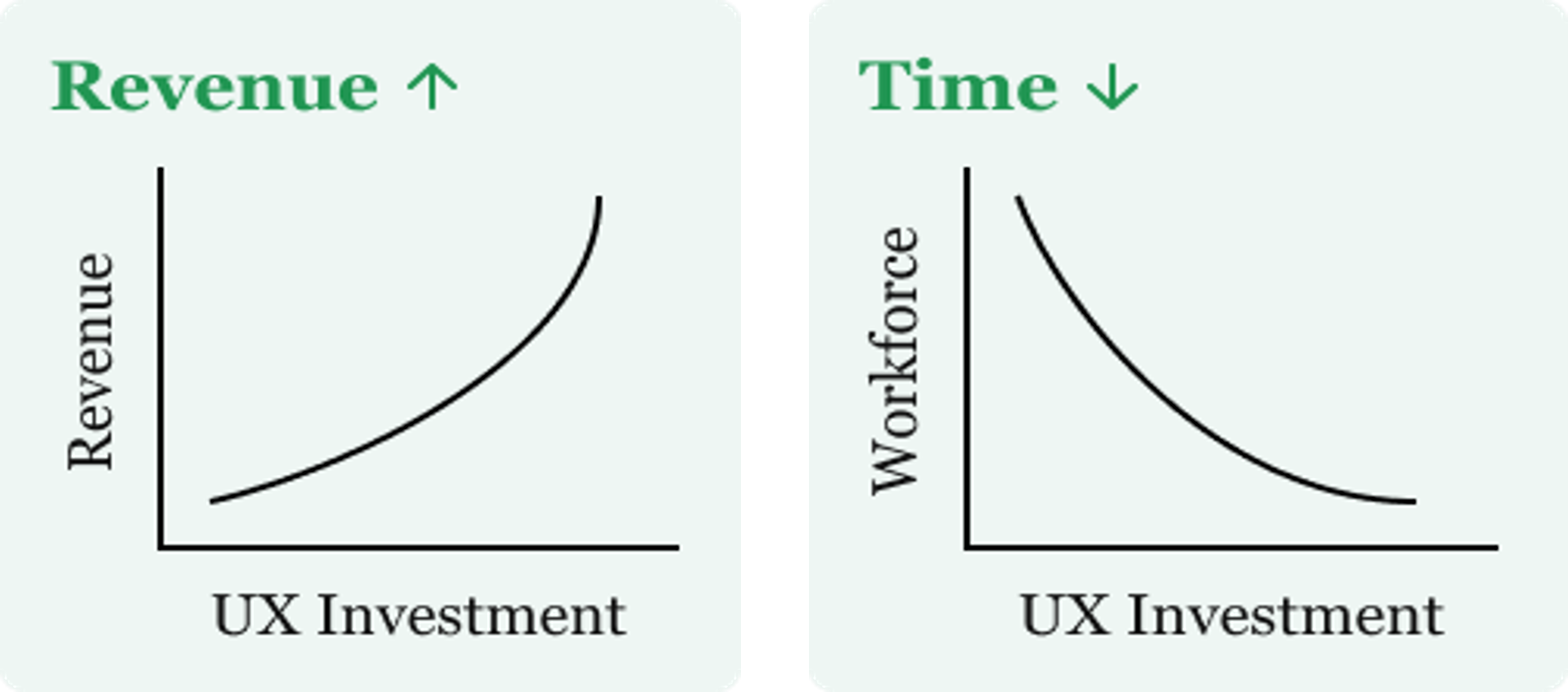



By Aman Gupta, Senior UX Designer
Since the past couple of years, the adoption of User Experience (UX) across customer journeys has been on the rise in most organizations. We have also started believing that UX is an important aspect of a successful business. So, should we be investing in UX because it’s trending or only for good returns?
Let’s see how many of you can relate to this. When it comes to product design, have you come across people with these queries:
- Can you enhance our application as per the current trend?
- Can you make it user-friendly?
- Can you quickly design 2-3 screens for our application?
- Why do you need so much time to design a few screens?
And many more...
If you can relate to these questions, then this blog is for you. One of the top UX designers Frank Chimero once said: “People ignore design that ignores people.”
The real reason why any business should invest in UX is that they care about the people, for them people matter the most. We will dive deeper into this thought through examples in the blog.
In his book, “Principles of Software Engineering Management”, Tom Gilbsays that each dollar spent on user experience (UX) yields an ROI between $2 and $100. In this blog, we will also be discussing the impact of UX on business and the potential returns any business can expect.
Basics - What is ROI?
Return on Investment (ROI) is a financial metric used to analyze the efficiency of investment usually in percentage. But calculating the ROI of UX is more about demonstrating that the design improving the user experience has a positive impact on the business goals – whatever those goals might be. Business goals often come down to revenue, but not always.
Here is an interesting story for you,
If you want to book a homestay, which application comes to your mind? Let me try and guess “Airbnb”, did I guess it right? But do you know in 2009, Airbnb almost went bankrupt, the company’s revenue was consistently low at $200 per week. But a small redesign helped them get back on track.
For businesses that are able to deliver a seamless digital experience across multiple online channels to their customers, the ROI expands to increased customer happiness. The consistent user experience across platforms will not just help the customers to get accustomed to digital services but also help them to stay loyal to the brand that made the transition to digital services seamless.
Another scenario, where UX can help you decrease questions to business support,
Imagine having a chatbot in your application making your team accessible to quick questions that employees may have. Who doesn’t like 24x7 service? The experience of interacting with a chatbot makes the application more enjoyable. Employees are more likely to ask clarifying questions with chatbots so that bounce rates (percentage of visitors who enter the application and then leave rather than continuing to view other pages within the same application) will be lower. Chatbots offer interesting insight into your product or application. We can also look at conversation logs to determine common questions and design accordingly.
These support requests from users could take any of the below forms:
“I can’t find...”
“How do I perform.... action”
“Is it possible to...”
We can improve user experience to reduce the questions that support teams receive. It will free up support team members so that they can focus on other important things rather than servicing clients with similar questions.
You can find many more scenarios like these. Something we should always keep in mind is that UX doesn’t show sudden and exponential growth in terms of revenue or customer retention. For this very reason, estimation of ROI becomes necessary to evaluate and compare different investments.
How to Calculate ROI?
ROI for businesses is generally computed as per the defined KPIs (Key Performance Indicator). However, most of the time it's practically impossible to calculate the ROI of a UX design at the start of the project, as the calculations are mostly assumed, these factors are calculated over a span with various tried and tested methods.
Once the product is released the choice of applicable ROI metrics is predicated on what business metrics are most important for achieving the aligned goals.
“Treat ROI as Estimation, Not Prediction. They can't (and don’t need to be) perfect. ~by Nielsen Norman
Using established metrics such as conversion rate, SUM, drop-off rate, bounce rate, NPS and others can show a clear sign of the effectiveness of the new design.
Continue reading, you will find an example of conversion rate at the end of this blog.
Potential Returns of User Experience (UX)
As per my research and project experiences, a stellar user experience can provide the following returns to a business:
- Increases user satisfaction
- Helps with user retention
- Enables faster user adoption
- Decreases user support
- Optimizes development time and cost
- Maximizes revenue generation opportunities
- Reduces training cost
- Prevents the risk of developing the wrong things

Different activities of UX process can offer you different ROIs
Let’s not be too greedy, it’s a team effort. There are different disciplines as well that play a huge role in the successful scoping, design, delivery, and marketing of a product. We also have a lot of help in the process from our Engineering Team and Product Owners.
Now you can set realistic expectations when it comes to the ROI of UX.

Let’s Hear From a Xoriant Leader
Shailesh Pardesi is an AVP of Technology at Xoriant who has been recommending UX for the last 11 years for his projects. For better clarity, we focused on a recently completed project for managing skill updates of employees. It’s a project which allows all the employees to timely update their skills and resume for matching them with new opportunities.
It is important for us to understand what we invested before expecting any returns.
- What are the different investments made while building the application w.r.t. money and efforts?
Moneywise: None, the team used whatever they already had.
Efforts: 3 full-time resources for development over a period of 6 months + 1 designer.
- Why did you consider UX design for his project, and what did you expect in return from the investment specifically in terms of UX?
First and foremost, have a clear vision of what’s needed and a focus on better requirement gathering. UX was considered to:
- Reduce development efforts concerning rework.
- Avoid usability challenges faced by users.
- Achieve faster user adoption.
- Save time on UAT testing with investment in UX design.
Strict deadlines were also one of the reasons why we couldn’t take the risk of building wrong things and lose time to rectify the issues later.
- What were the results after the application release?
The organization’s goal was to have the updated skills and resumes of all the employees by June 2021.
Actual Target: 100% employees to update skills and resumes.
Margins: 10-15% considering employees on client projects or other locations who might or might not have the access to the application.ROI calculation using conversion rate,
Conversion rate = (No. of Updates / Total Visitors) x 100So, 2984 users visited the application and 2752 of them updated their skills, then the conversion rate percentage of the updates can be calculated as
(2752/2984) x 100 = 92%.Achieved Target: Within 5 months after realizing the application we have gathered the skills and resumes of more than 90% of employees and ongoing. Isn’t this great!
The Revenue Angle
When you consider the design of this application, it reduces: -
The amount of time it takes for employees to update their skills and resume.
-
The time spent by other employees in following up to get updated skills and resumes from others.
-
The time spent by Project Managers to ask for updated details every time they need one from an employee and every other employee who is involved in the process.
To calculate the time savings, we can multiply the time reduction by average hourly pay, the number of employees, and the frequency of the task.
That multiplication gives us cost savings every year — in other words, by improving the efficiency of these employees, we estimate that we’re now investing costs elsewhere that would have otherwise been used for resources to do an inefficient task.
Final Thoughts
UX design if done properly can offer excellent ROIs that go well beyond the most immediate benefit to the user. Design shouldn’t always be scrutinized as an expense, the investment of an honest design also can be valued through its capability to interact, influence, and keep a user loyal to the product or brand.
UX helps in creating a vision and a road map that will both delight users and provide noticeable business results. Spending a little time and money on drafting an enjoyable user experience with appropriate user research and testing of digital products can translate to massive revenue growth.
Looking to modernize customer experience with a rich user experience and user interface? With Xoriant UX experts, stay ahead of the curve by investing in the latest research and next-gen technologies to enable your team to exceed customer and market expectations.
To discuss how Xoriant helps improve ROI for businesses with amazing UX,



 View Previous Blog
View Previous Blog




